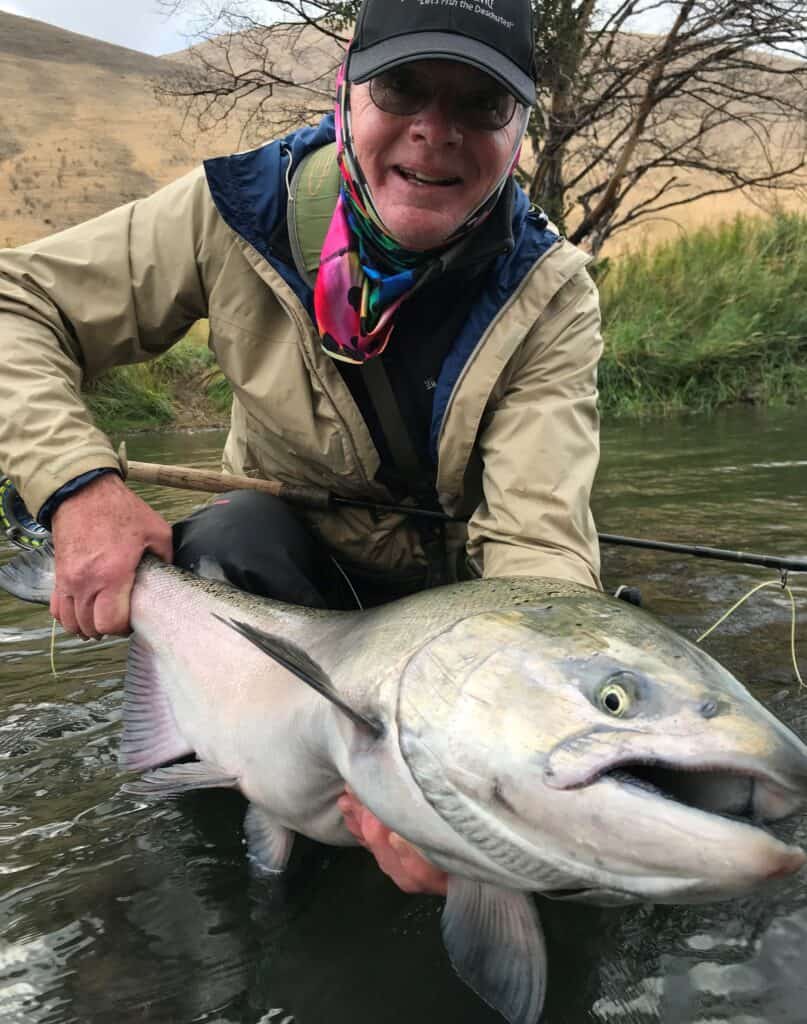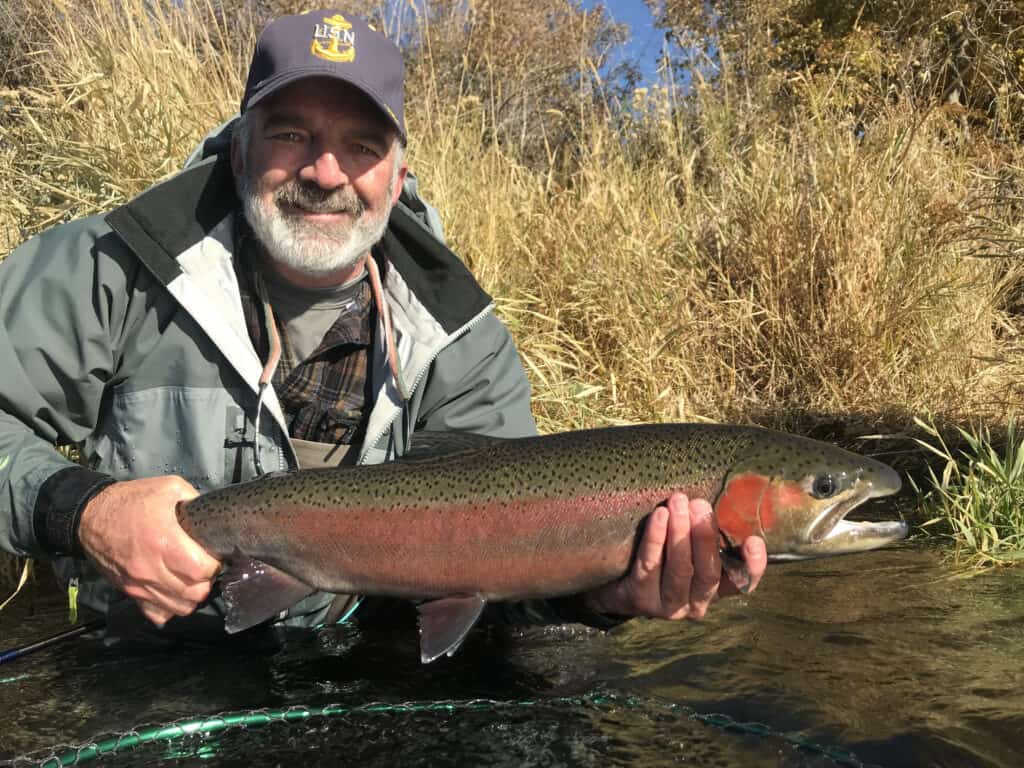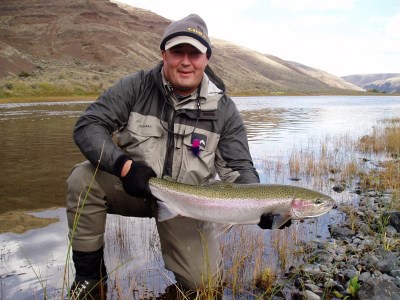Above Bonneville Dam, Oregon’s length of the Columbia River is a series of long reservoirs, often known as “pools,” formed by giant hydroelectric dams.
Summer steelhead pass through this part of the big river by the tens of thousands, on their way to hatcheries and spawning grounds scattered across the interior of Oregon, Washington and Idaho.
We should acknowledge that as of our last update of this article, steelhead runs into the mid-Columbia River mainstem and tributaries has been quite depressed, but we’re hopeful things will turn around.
The following are some of the best steelhead waters in this part of the state, which includes the famous Deschutes River.
Columbia River
The main river not only brings the steelhead to smaller tributaries, it’s an excellent fishery in its own right.
Most of the pools will produce 1,000 or more keepers per season, plus some catch-and-release action for wild steelhead that rear in the region’s streams.
Trolling wobbling plugs and other lures is popular in the main river, with much of the action focused around tributary mouths and in the current below each dam
You can fish with your Oregon license and tag in the main river, but check regulations before venturing up into a Washington stream.
Bonneville Pool (Bonneville Dam to The Dalles)
This reservoir has produced well under 1,000 most recent seasons, down from earlier years.
The peak month is typically August. Traditional spots to catch them are tributary mouth fisheries can be found at Herman Creek near Cascade Locks and Hood River.
An update is that Herman Creek (among others) has recently been subjected to a restricted fishery at its mouth to provide a sanctuary area for migrating fish. Check regulation updates before fishing.
On the Washington side, the mouths of steelhead rivers like the Wind and Little White Salmon (Drano Lake) rivers are choices.
The Dalles Pool (also known as Lake Celilo, between The Dalles and John Day dams)
Anglers in this pool have tagged very few fsummer steelhead a year in recent seasons, with catches usually starting in July, peaking in August, and sometimes continuing fair to good into October.
The major tributary in this section is the Deschutes River, an easy drive east of The Dalles.
The Deschutes not only hosts this area’s premier summer steelhead run but draws in steelhead from other rivers into its cold lower reaches to wait out warm summer conditions on the Columbia.
While more fish are caught on the Deschutes itself, they also have historically been caught in the Columbia off the mouth.
However, both the Columbia River near the Deschutes mouth and the lowest section of the Deschutes itself are protected by a seasonal closure to provide a protected refuge for fish riding out the intolerably hot water temperatures in most of the Columbia during late summer and early fall.
Definitely watch for in-season updates when Columbia River summer and fall seasons are set, usually during spring.
When fish passage is building over John Day Dam near Rufus, fishing the current below the dam can be productive.
John Day Dam Pool (also known as Lake Umatilla, between the John Day and McNary dams)
This is a very large pool.
The John Day River, which has a strong wild summer steelhead run and also attracts a few hatchery steelhead strays, flows into the lower section of the pool.
Note that if you turn into the John Day Arm, special rules may apply.
The Umatilla River, which has summer steelhead and several salmon runs, flows into the upper end near Umatilla.
Fish often congregate in the upper end, waiting to either migrate up the Umatilla or over the dam.
Catches begin when the first summer steelhead bolt upriver in about April. Some years the catches will improve again in October or November, and cooler fall weather finally convinces upriver steelhead that it’s time to move.
McNary Pool (above McNary Dam)
The lower section of this pool includes the Oregon side of the river, while the upper part is entirely in Washington.
Fishing success here can vary widely. In recent years, fewer than 1,000 have been caught per season, down from some previous banner years (i.e. more than 3,000 in 2009).
Most of those fish are landed between September and December, as steelhead pull out of cooler summertime refuge areas downstream and continue their migrations into Washington and Idaho. October can be very good.
For other fishing opportunities in this river, read Columbia River Fishing.
Deschutes River

One of Oregon’s best summer steelhead rivers offers a tale of two rivers.
At the mouth and in the lower reach, steelhead start arriving in July and build up numbers during late summer and early fall.
During the late summer time, both Deschutes and upper Columbia River steelhead turn into the cooler waters of the Deschutes, resulting in an extra large concentration of steelhead in late summer and early fall when the Columbia runs warm.
However, in recent years the very lowest section of the Deschutes River below a marker at Moody Rapids has been subjected to a closure period as well as reduced harvests at other times during the warmest part of the year.
Also, the river above Moody also is closed under newer rules at the traditional start of this run. ODFW may open the river from Moody upstream to Pelton Dam beginning in mid-August, as long as enough fish are coming over Bonneville Dam.
A decade or more ago when runs were stronger than they are now, and before the refuge areas came into play, there had been some crazy high steelhead catches in this area. In 2009, more than 10,000 steelhead were tagged, if you can believe that.
Some anglers fish the lower river using jet boats powered up the river from Heritage Landing and Deschutes River State Park at the mouth to get to favorite holding water above Moody Rapids.
There also is bank access by hiking or mountain biking up a trail, but note the lower river fishing closures.
The river can also be floated from several launch sites below Sherars Falls to the mouth of Macks Canyon, or intrepid and well-equipped boaters can put in above Macks and float through, stopping to fish and camp.
Success in the lower Deschutes usually tapers off quickly during the fall, when the steelhead there either move into the upper river or back out to the Columbia River and head east.

Usually by sometime in October, most steelhead and steelheaders have moved on, often upstream on the Deschutes.
In fact, October is the peak of the season above Sherars Falls. Up here, an area that includes the Maupin and Warm Springs areas, the first fish make their way over the falls in September.
Fishing can remain good through November and sometimes into December.
The river is open year-round for adipose fin-clipped steelhead between the Warm Springs Indian Reservation and the mouth. There are seasonal closures where the river borders the reservation up to Pelton Dam. The open area can produce modest numbers of steelhead into late winter.
The river between Sherars Falls and Pelton Dam can produce fewer than 1,000 hatchery steelhead some years, which is the case lately, and up to 5,000 during a great season.
While the numbers here are typically lower than closer to the mouth, this long stretch is particularly beloved by fly anglers fishing for steelhead and is on our list of best fly fishing rivers in Oregon.
There is a variety of bank access, particularly on around Maupin and up near Warm Springs. Several launches offer interesting floats with varying degrees of difficulty. Do not navigate Sherars Falls.
Throughout the Deschutes, note that anglers must step out of their boats to fish (unless they have a special permit for disabled anglers).
Note also the special rules that apply to the river bordering the reservation, and that boaters need a seasonal pass to float the river during the high season, which overlaps part of the steelhead run.
For an overview of fishing this river: Deschutes River Fishing.
Hood River
This Columbia Gorge stream has both summer and winter runs of steelhead, capable of producing anywhere from maybe just a 100 to more than 1,000 fish from each.
The first summer runs arrive in April through June, but they can be caught nearly any day of the year. In fact, many are caught during the winter and early spring, when anglers often target the newly arrived (and in this season brighter) winter run fish.
Since the removal of Powerdale Dam, which used to be a focus for steelhead fishing effort, the mainstem is open up to the forks. Steelhead must have a clipped adipose fin to keep throughout the Hood River system.
John Day River and John Day Arm
The John Day is an excellent wild steelhead river with a modest number of fin-clipped steelhead in the mix.
Fishing here gets going in the fall, once cooler temperatures flush out the warm summer water. (This river is warm enough to also host some of the best smallmouth bass fishing anywhere.)
Steelhead catches often peak in October and November in the long free-flowing river above Tumwater Falls, nearly 10 miles up from the mouth. After that, especially frigid weather takes over and limits fishing opportunity.
Catches can be good again later in the winter, during breaks in the weather.
While catch reports don’t do this river justice — because the strong majority of fish are wild and must be released — the harvest of hatchery fish is modest most years.
Another part of the John Day fishery is the John Day Arm, an almost 10-mile finger from the mouth up to Tumwater Falls. The water backs up to the falls due to John Day Dam just downstream on the Columbia River.
This waterway is typically fished by boat launched from Le Page Park at the mouth. Anglers often troll wobbling plugs or other lures in the lake-like water.
However, note that in recent seasons fish managers have set a fishing refuge to protect salmon and steelhead in the John Day Arm, specifically from Tumwater Falls down to the Columbia River.
Check for updated regulations for Columbia River salmon and steelhead fisheries, often released in the spring.
If allowed to fish the Arm, historically catches have been best in October and November.
Umatilla River
The Umatilla is a relatively small producer of summer steelhead, sending some 400 to 600 fish to the dinner table in some of the better recent seasons, but far fewer (measured in the few dozens) when the runs are down.
This river flows through the heart of Northeast Oregon’s argicultural country near Hermiston and Pendleton, joining the Columbia River at the city of Umatilla just below McNary Dam.
The river is fished for steelhead from the mouth (Highway 730 Bridge) up to the boundary of the Umatilla Indian Reservation on the east side of Pendleton.
Most of the summer steelhead here arrive in September and October, with fishing continuing into early spring. The river above Nolin to the deadline is typically better in the few months before harvest closes after April 15.
Return to Oregon Steelhead Fishing Page
Oregon Resources
ODFW Weekly Fishing Report
ODFW Trout Stocking Schedule
Oregon Fishing Regulations
National Weather Service

